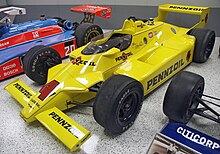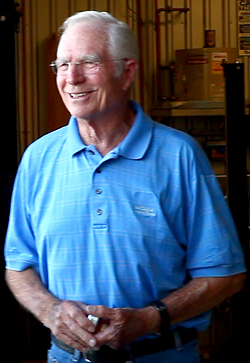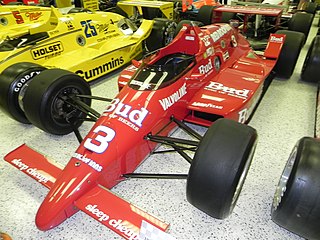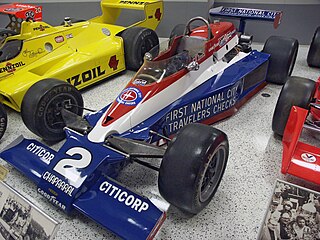Models
1

In 1957, Hall raced the front-engined Chaparral (retroactively called the "Chaparral 1") through 1962, bought from Troutman and Barnes (like the Scarab, the Chaparral 1 cars were built in California by Troutman and Barnes). Hall and Hap Sharp extensively modified their Chaparral and eventually decided to build their own car. They obtained permission from Troutman and Barnes to use the Chaparral name, which is why all of Hall's cars are called Chaparral 2s.
2





The first Chaparral 2-series was designed and built to compete in the United States Road Racing Championship and other races of the time, particularly the West Coast Pro Series that were held each fall. Hall had significant "under the table" assistance from GM, including engineering and technical support in the development of the car and its automatic transmission (this is evidenced by the similarity between the Chevy Corvette GS-II "research and development" model and the Chaparral 2A through 2C models).
First raced in late 1963, the Chaparral 2 developed into a highly competitive car in the Can-Am series in 1966 and 1967. Designed for the 200-mile races of the Can-Am series, it was also a winner in longer endurance races. In 1965, it shocked the sports car world by winning the 12 Hours of Sebring in a pouring rainstorm, on one of the roughest tracks in North America.
The Chaparral 2 featured the innovative use of fiberglass as a chassis material. The Chaparral 2C had a conventional aluminum chassis.
It is very difficult to identify all iterations of the car as new ideas were being tested continually.
- The 2A is the car as originally raced, featuring a very conventional sharp edge to cut through the air. It also featured a concave tail reminiscent of the theories of Wunibald Kamm. The first aerodynamic appendages began to appear on the 2A almost immediately to cure an issue with the front end being very light at speed with a consequent impact on steering accuracy and driver confidence.
- As the car evolved, it grew and changed shape. Most call these 2B and were raced through the end of 1965.
- The 2C introduced the innovative in-car adjustable rear wing. The integrated spoiler-wing was designed to lie flat for low drag on the straights and tip-up under braking through the corners. The car's clutchless, semi-automatic transmission kept the driver's left foot free to operate the wing mechanism. The 2C was based on a Chevrolet-designed aluminum chassis and was a smaller car in every dimension than the 2B. Without the natural non-resonant damping of the fiberglass chassis, Hap Sharp nicknamed it the EBJ — "eyeball jiggler".
Alongside the development of aerodynamics was Hall's development of race tires. Jim Hall owned Rattlesnake Raceway, located adjacent to his race shop; its proximity allowed him to participate in much of Firestone's race tire development.
A two-article series in Car and Driver magazine featured Hall's design theories, turning speculation about vehicle handling into applied physics. Hall's theories were the precursor to the elaborate data collection and management of current racing teams.
The 2D was the first closed cockpit variant of the 2-series, designed for endurance racing in 1966. It won at 1000 km Nürburgring in 1966 with Phil Hill and Joakim Bonnier driving. It also competed in the 1966 24 Hours of Le Mans, withdrawing after 111 laps. The Chaparral 2D was equipped with a 327 cubic-inch displacement (5.3-liter) aluminum alloy Chevrolet engine producing 420 horsepower; the car weighed only 924 kg.
The 2E was based on the Chevrolet-designed aluminum 2C chassis and presented Hall's most advanced aerodynamic theories to the racing world in 1966. The 2E established the paradigm for virtually all racing cars built since. [3] It was startling in appearance, with its radiators moved from the traditional location in the nose to two ducted pods on either side of the cockpit and a large pivoting variable-incidence wing-mounted several feet above the rear of the car on struts. As opposed to an aircraft wing, it generated downforce instead of lift and was attached directly to the rear suspension uprights, loading the tires for extra adhesion while cornering. A ducted nose channeled air from the front of the car upwards, creating extra downforce as well. By depressing a floor pedal that was in the position of the clutch in other cars, Hall was able to feather or flatten out, the "normally" negative-incidence wing's angle when downforce was not needed (as on a straight track section) to reduce drag and increase top speed. An interconnected air dam also closed off the nose ducting for streamlining. When the pedal was released, the front ducting and wing returned to full downforce position. Until they were banned, many race cars, including some in Formula One, had wings on tall struts. The resulting accidents from their failures led to pivoting wings mounted on the suspension prior to being fully banned.
The 2E scored only one win, at the 1966 Laguna Seca Raceway Can-Am with Hill driving. Hall stuck to an aluminum 5.3-liter Chevrolet engine in his lightweight racer while the other teams were using 6- to 7-liter iron engines, trading weight for power.
The 2E was a crowd favorite and remains Hall's favorite car.
In the 2F Hall applied the aerodynamic advances of the aluminum 2E to the older fiberglass chassis closed-cockpit 2D for the 1967 racing season. A movable wing mounted on struts loaded the rear suspension while an air dam kept the front end planted. The radiators were moved to positions next to the cockpit. [4] An aluminum 7-liter Chevrolet 'big block' engine replaced the 5.3-liter engine of the 2D. While always extremely fast, the extra power of the larger engine was too much for the automatic transmission to handle and it broke with regularity. After solving the transmission problems, the 2F scored its only win on 30 July 1967 in the BOAC 500 at Brands Hatch with Hill and Mike Spence driving. [4] After this race the FIA changed its rules, outlawing not only the 2F but also the Ford GT40 Mk.IV (winner at Le Mans that year) and the Ferrari 330 P3/4 (winner, 24 Hours of Daytona) and 365 P4 (finished second, Le Mans). [4] As with the 2D, the 2F raced wearing Texas license plates.
The 1967 2G was a development of the 2E. It featured wider tires and a 427 cu in aluminum Chevrolet V-8 engine. While on par with its competitors in terms of power, the lightweight 2C chassis was stretched to the limit and it was only Hall's driving skills that kept the car competitive. For the 1968 Can-Am series, still larger tires were added to increase grip.
Hall's racing career was effectively ended in a severe crash at the Stardust Grand Prix Can-Am race when he rear-ended the slow-moving McLaren of Lothar Motschenbacher, although he did drive in the 1970 Trans-American Sedan Championship while fielding a team of Chevrolet Camaros.
Hall noted that the increasing downforce also created enormous drag. Seeking a competitive edge, the highly advanced 2H was built in 1968 as the replacement for the 2G to minimize drag. Not only was it extremely slippery, it was narrow to reduce frontal area. Development problems kept it out of the Can Am series, forcing Hall to update the 2G for the 1968 series, during which his catastrophic accident occurred. Hall was consistently the best driver for Chaparral and knew how to get the best out of his cars. John Surtees was brought in as driver for the 1969 Can Am series but never figured out how to drive the 2H to take advantage of its low drag potential. Surtees complained he couldn't see out of the car and demanded a redesign which ruined the aerodynamics, then ran the rear wing almost upright, negating any advantage of the compact slippery shape. Ultimately, by 1969 the massive amount of power being generated from the big block Chevrolet engines that Hall effectively debugged in 1967 and 1968, downforce was more important than low drag. Had the 2H kept the low drag shape but with a wider track it most likely would have been very competitive, but the true monocoque construction made changes to the chassis almost impossible. Beautifully constructed, the 2H looks as if it was made by NASA.
2J

The most unusual Chaparral was the 2J. On the chassis' sides bottom edges were articulated Lexan plastic skirts that sealed against the ground (a technology that would later appear in Formula One). Two fans adapted from a military tank engine were housed at the rear, driven by a single two-stroke twin-cylinder engine. [5] The skirting produced a zone within which the fans could create a vacuum producing downforce on the order of 1.25 to 1.50 g when the car was fully loaded (fuel, oil, coolant). Tremendous gripping power and greater maneuverability at all speeds were produced. [6] [7] [8] [9] [10]
The 2J competed in the Can-Am series and qualified at least two seconds quicker than the next fastest car, but mechanical problems limited its success. It only ran in the 1970 season, after which it was outlawed by the Sports Car Club of America (SCCA). Although originally approved by the SCCA, they succumbed to pressure from other teams who argued that the fans constituted "movable aerodynamic devices". Sanctioning body FIA had banned such devices beginning with the 2E. There were also complaints of debris generated by the fans damaging the following cars. McLaren argued that if the 2J were not outlawed, the Can-Am series would be ruined by its dominance – something McLaren had been doing since 1967. [11] A similar fan was used in Formula One in 1978 on the Brabham BT46B. [12] [13] [14] [15]
2K

The 2K was a Formula One-inspired ground effect Indy car designed by Briton John Barnard. Debuting in 1979 with driver Al Unser Sr., it went on to win six races in 27 starts over three seasons. Its greatest success came in 1980 when Johnny Rutherford won both the Indy 500 and CART championship. [16] [17] [18] [19] [20] [21]

















